Arthrosis in horses
Arthrosis - what is it?
The word "arthrosis" is heard again and again when talking to owners or grooms of older horses, because older horses in particular are often affected by arthrosis. But what exactly is behind this disease?
Arthrosis is generally understood to be a progressive, degenerative joint disease, which can be divided into different stages. The joints and their structures - the cartilage and the bones of the affected joint - are involved in this disease. In most cases, the joint space and the surrounding ligaments are also affected.
It is important to know: Arthrosis is irreversible. This means that once it has started, it cannot be reversed! At first glance, this sounds very bad and hopeless, but it is by no means hopeless. It is possible to help the affected animal! As described above, arthrosis can be divided into different stages and thus determine how bad and advanced the arthrosis is. Regardless of the degree, it is important to slow down the progression of the arthrosis and help the horse to relieve the pain.
If an arthrosis disease is still at the very beginning, it is hardly recognized by many riders and owners because the symptoms are only very slight or not noticeable at all. Most of the time, the horse only shows very small signs of change that are quickly overlooked. It is precisely these signs that we want to explain, because this is exactly the degree of arthrosis where one can still best help and support.
Tip: Arthrosis first describes "only" the degenerative change of a joint and its involved structures. If it is an (additional) inflammation, it is called arthritis.
Arthrosis = degenerative change of the affected joint and surrounding structures.
Arthritis = inflammation of the joint
Most arthroses only become noticeable when the horse are obviously in pain and express it. One of the most common symptoms is lameness and/ or a clammy, stiff gait at the beginning of riding. The horse's mobility is restricted. With such symptoms, the arthrosis is already somewhat advanced. But even at this degree, there are still many ways to help the horse!
Tip: The degree of arthrosis is classified according to the involvement and disease of the affected joint and its structures. If the cartilage is still very well preserved and the joint space has its physiological width, this is referred to as grade I.
If the cartilage is already worn away and shows small fissures or holes, the classification grade - depending on the severity - becomes higher. In the highest degree of arthrosis, there is hardly any cartilage mass left. There is a very small joint space and the bone ends of the joint can already rub against each other. Our task as pet owners is to keep the degree of arthrosis as low as possible and to slow down the process as much as possible. YES, this is possible!
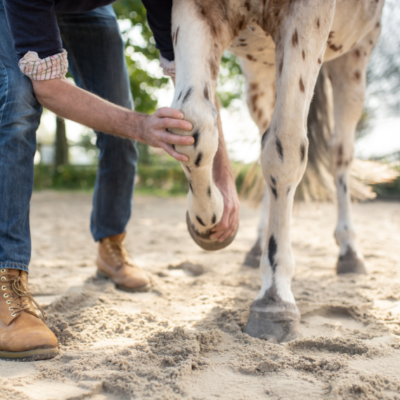
How does arthrosis develop?
The development and thus the causes of arthrosis are very versatile. This is already clear from the definition of arthrosis, because almost every type of degenerative change in a joint is arthrosis. The causes can therefore come from the most diverse areas, from horse management to feeding to (athletic) exercise.
Even young horses can develop arthrosis. In this case, the feeding of the mother (the mare) and the feeding of the foal itself play a major role. Due to the altered and/ or faulty development of the foal, arthrosis can already occur at a very young age.
Once the horse is fully grown, it is possible to hear the diagnosis "joint chip" or OCD (short for osteochondrosis) during an examination. This joint disease also falls under the category of arthrosis, as it involves changes to/ in the joint. With "joint chips" and/ or OCD, the causes are also very diverse.
The most common causes are accidents and feeding errors or incorrect movement as well as loading of the horse.
Regardless of the type of arthrosis, we will now take a closer look at the main causes:
- Horse management
From birth, the horse's attitude is an important factor for the correct development of the young horse. Even foals should have enough exercise and be able to move freely over a wide area. The tendons and ligaments are stressed in a natural way and the skeleton can develop according to its age. If foals or young horses stand in too small or cramped spaces, the natural regular movement is missing. The lack of exercise can lead to poor development of tendons and ligaments and too much stress on the joints. The risk of developing arthrosis at an early age is high.
Older horses and especially "seniors" should also have enough space to run free every day to be able to move around in an age-appropriate way. Different ground conditions, a dry shelter and a damp-free place to lie down and sleep should be provided.
- Exercise
Regular exercise is of fundamental importance for the horse's musculoskeletal system. You can imagine the cartilage in the joint like a sponge. If you lay the sponge on its side without moving it, it will dry out and become hard and cracked over time. If we were to hold it in our hands, we would hardly be able to squeeze it and it would hardly yield to the pressure of our fingers. However, if we move the sponge in water every day, it soaks up and becomes very soft. It lies comfortably in the hand and can flexibly adapt to all movements. We have "nourished" the sponge with water through our movements, so to speak, and thus preserved its function.
If we now relate this example to the cartilage in the joint, whose function is to cushion loads and protect the bones from pressure and tensile loads, the importance of movement quickly becomes clear here too. If the horse moves regularly, the cartilage is "nourished" with blood and minerals through movement so that it remains smooth and flexible and can perform its buffer function in the joint.
It is important to understand that any kind of excessive rest, but also any kind of excessive stress, can damage the cartilage and thus the joint. Standing for hours is just as damaging as heavy exertion for hours.
Tip: A cartilage needs about 15-20 minutes until it has reached its full buffer function. Warming up before exercise is therefore extremely important to avoid possible damage to tendons, ligaments and cartilage and thus protect the horse as best as possible from the risk of arthrosis.
- Feeding
As with almost every disease, feeding also plays a major role in arthrosis. Only if the horse is fed a healthy diet it can develop according to its age and build up all the necessary structures for later stress. Even when the horse is fully grown, it constantly needs new "building blocks" to build up or renew muscles, bones, ligaments, tendons and cartilage. The horse's musculoskeletal system never stands still. We can't see it from the outside, but the horse is constantly rebuilding its body - and that's a good thing! Our four-legged friends are excellent at adapting to new conditions. For example, if we increase the training, the horse will automatically build up more muscle mass and strengthen the bones. If we warm up our horse well before every training, the cartilage is sufficiently "nourished" and its function is maintained. If the horse is injured, the body will immediately start to replace and/ or rebuild the "broken part". For all these processes, however, the organism of our horses must be well supplied, otherwise it cannot perform these processes or can only do so inadequately. If the horse is not sufficiently supplied with important nutrients, a feed-related deficiency can lead to the restructuring and rebuilding processes in the body running too slowly or incorrectly - the consequence: diseases can develop in the musculoskeletal system.
Optimal feeding can therefore also go a long way towards protecting the horse from possible diseases of the musculoskeletal system and thus also from arthrosis.
How do I recognise arthrosis?
The symptoms of arthrosis are at least as varied as the causes themselves. Each type of arthrosis can have different effects on the horse. In addition, every horse reacts differently. Nevertheless, there are guiding symptoms that every owner can look out for and that can give an indication of the disease. As already explained, arthrosis can be divided into different stages, whereby arthrosis in the early stages is an incidental finding, as the horses usually do not yet have too much pain and the symptoms are very slight. A regular check-up of the joints by a veterinarian, alternative practitioner or osteopath makes sense in any case and with any horse, at the latest, however, when you can observe the following symptoms in your horse:
- Changed gait
The horse changes its gait. It does not always have to be lame. Maybe the horse steps a little shorter at the walk (the horse takes smaller steps than usual) or it no longer jumps as well at the canter (the canter jump becomes flatter).
- The horse walks "sensitive"
Walking sensitive means that the horse shows different gaits on different surfaces. If the ground is too hard, the horses often walk reluctantly or very stiffly. If the ground is too deep, the horses are clearly unmotivated and do not want to/ can not muster any strength.
- The horse has to walk a while before it can take up load
The horse needs longer to loosen up and to develop a swinging, springy gait from an initially somewhat stiff step.
- Difficulty in taking up load
The horse finds it significantly more difficult to take up load. It shortens its steps and prefers to walk with small, quick steps rather than with large, ground-covering steps. The short step is easier on the joints and is therefore making it more comfortable for the horse. If the arthrosis is in the hindquarters, the horse may walk "downhill". This means that the horse either lifts its head further up or stretches its nostrils towards the ground. Walking through the neck is difficult for the horse because in this posture it has to put weight on the hind legs, which may cause pain.
- Avoiding tight turns and quick changes of pace
Tight turns put a lot of stress on the joints involved. If arthrosis is present, the horse will try as hard as possible to avoid pain and will therefore be reluctant to run in tight turns, such as a volt. Rapid changes of pace, such as walk-canter transitions, also put increased strain on the joints, so that the transitions also become unpopular with the horse.
- Impaired rhythm and lameness
If the horse shows lameness or imprecision of rhythm, especially in the warm-up phase, this can be an indication of arthrosis. The horse "limps" a little or you can see that it does not want to step properly on one leg. Short steps at the beginning of the exercise are a leading symptom. This means that the tact impurity and/ or lameness become less after the horse is warmed up for the following exercise. In the beginning you can tact impurity and/ or lameness clearly, towards the end hardly at all.
The list of symptoms could of course be extended at will, but in this case it is about the leading symptoms that can give every owner and carer an indication of a possible (development of) arthrosis. However, the symptoms listed above can also indicate other diseases, so that clarification with a veterinarian, alternative practitioner or osteopath is recommended in any case!
Tip: Arthrosis is in most cases very weather-dependent, so that the symptoms are more noticeable in wet and cold weather than in warm weather. The reaction to such weather changes is also an indication of a possible arthrosis.
What can I do against arthrosis?
Now the time has come. The symptoms have been recognized and a firm diagnosis has been made: The horse has arthrosis.
But what is the best way to help the horse now?
Of course, the diagnosis of arthrosis is not a nice thing to hear, but the fact that there are many possibilities to help the horse is even better. In the following, we will concentrate only on the point of feeding and leave out all other, numerous therapy possibilities.
The point of feeding alone will arouse enthusiasm and hope.
- Devil's claw
Devil's claw is a root that can help with diseases of the musculoskeletal system. It is said to have an anti-inflammatory effect that can relieve the pain of arthrosis.
However, devil's claw needs about two weeks before it can show its effect. It therefore makes sense to feed it for at least 6-8 weeks. If the horse responds well to devil's claw and the symptoms of arthrosis subside, the root can be fed for a longer period without any problems. Especially when arthritis, an inflammation of the joint, is present, the administration of devil's claw can be supportive. In case of arthrosis, devil's claw is a "must-have" in the horse's pharmacy.
- Green-lipped mussel powder
The connective tissue, and thus the important component of cartilage, also wants to be nourished. The cartilage prefers glycosaminoglycans, which are contained in the green-lipped mussel, for its supply. Green-lipped mussel powder can therefore help to supply the cartilage with important nutrients and maintain its buffer function in the joints to protect against possible signs of wear.
- Rosehips
Due to their high vitamin C content, rosehips can not only strengthen the horse's immune system, but also have a positive effect on arthrosis.
- Ginger
Arthrosis is known to occur in episodes. In an acute episode, the administration of ginger can inhibit the inflammation and the acute pain can be relieved. However, ginger should only be given during the acute phases of arthrosis and should not be given permanently. Ginger should be given for a maximum of 6 weeks at a time.
Caution: Devil's claw and ginger should not be fed together, as their reactions in the body are opposed to each other. If you feed ginger for a short acute period, you should take a short break from devil's claw.
- Linseed oil
The all-round talent linseed oil can also help with arthrosis/ arthritis. Linseed oil contains a high proportion of omega-3 fatty acids, which are said to have an anti-inflammatory and pain-relieving effect.
- Stiefel Arthro Liquid
Stiefel Arthro Liquid with liquid devil's claw and artichoke can have a positive effect on joint, tendon and cartilage problems and thus support the entire musculoskeletal system. Especially in the case of chronic or acute joint problems, Stiefel Arthro Liquid can provide relief.
- Stiefel Arthro Plus
Stiefel Arthro Plus contains a special blend of New Zealand green-lipped mussel powder, a herbal mixture with devil's claw and balanced vitamins and can therefore positively support both joints and tendons of the horse. Stiefel Arthro Plus can promote healthy movement and positively influence the synovial fluid in the joints.
With this list, one quickly realizes that there are many ways to help a horse suffering from arthrosis. Arthrosis cannot be reversed and unfortunately it cannot be cured. Nevertheless, one should not simply accept this disease passively, but work actively to stop the process of arthrosis as best as possible.
So cheer up, arthrosis is treatable! The horse will thank you for it.
Latest reviews
-
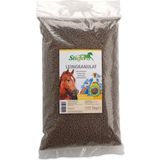 5.0 (7)
5.0 (7)Stiefel Linseed Granules, 5 kg
- Ready-to-feed linseed cake
- High mucilage content
- Reduced fat content due to cold pressing
£17.80 (£3.56 / kg)Delivery by January 14
-
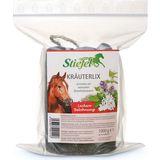 4.8 (10)
4.8 (10)Stiefel Kräuterlix Horse Lick, 1 kg
- Lick stone with bronchial herbs
- A tasty reward
- With attached cord to tie it up
£13.33 (£13.33 / kg)Delivery by January 20
-
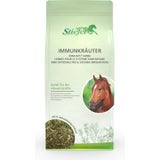 5.0 (8)
5.0 (8)Stiefel Immunity Herbs , 1 kg
New!- 100% natural herbal mixture
- Immunity herbs
- Good for the body's defences
£22.27 (£22.27 / kg)Delivery by January 14
-
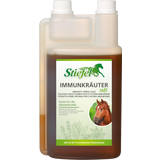 4.8 (6)
4.8 (6)Stiefel Immunity Herbal Liquid, 1 l
Bestseller- To support the immune system
- Made of 100% natural herbs
- No added sugar
£15.12 (£15.12 / l)Delivery by January 14
-
Great Britain: Free standard delivery from £79.90
-
Free
returns Secure payments
with SSL encryption technology

